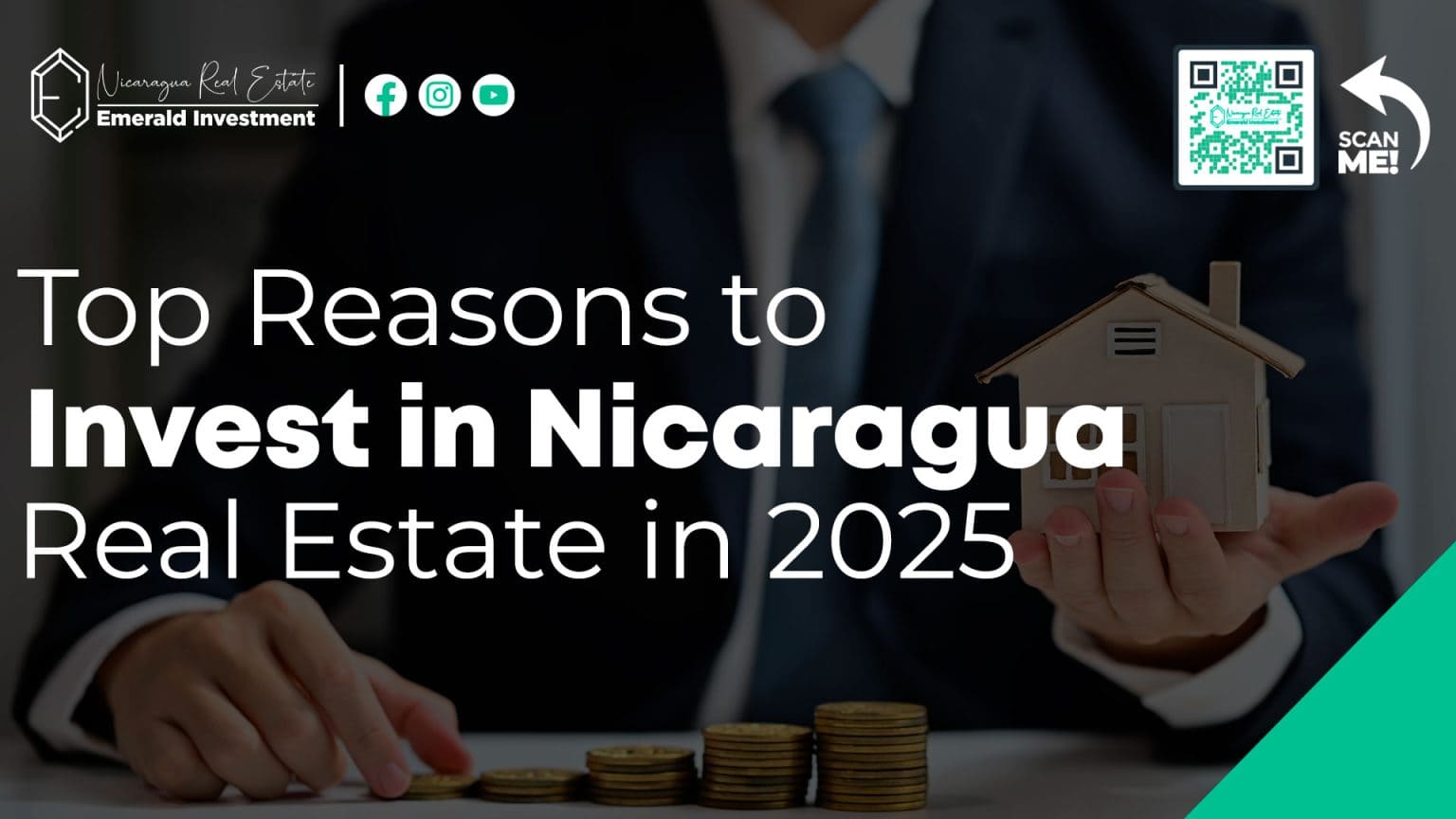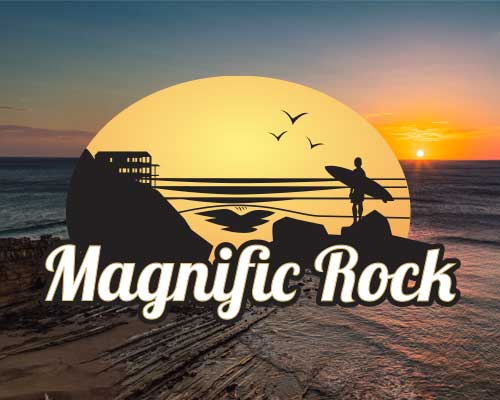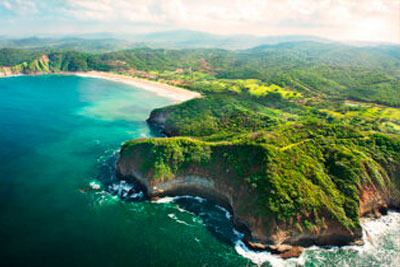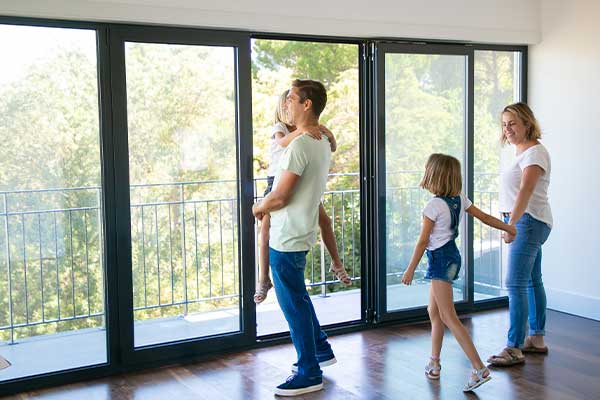For the last year or so, inflation and the cost of living have risen rapidly around the Western world. However, the cost of living in Nicaragua in 2024 is still extremely affordable. Whether you’re looking for a place to retire, thinking about working remotely from Nicaragua or just looking for a more cost effective place to spend some time traveling, Nicaragua’s Emerald Coast is affordable, vibrant and full of opportunities.
With low cost property options (for rent or to buy), value for money home services, inexpensive food and entertainment that stretches the value of your buck further than at home; the cost of living in Nicaragua really is something to consider if you’re looking for a lifestyle change. In recent years, many digital nomads and retirees have found excellent places to base themselves in Nicaragua. For around $3,500 USD a month, we’ll explain how a couple can live comfortably in a gated beach community in Nicaragua.
Defining a “Cost of Living”
The term “cost of living” has come to signify the amount of money that a person needs to live, but it covers more than that and of course, different people require different needs to live. In 2024, it usually means the minimum viable amount that somebody requires to survive in terms of housing, food and basic necessities. Implicitly, this definition relies on the assumption that each person is earning wages or a salary, in order to purchase what they need. Over the last year, the world has been hit by rising costs and shortages in fuel, certain food necessities and affordable housing – yet Nicaragua has managed to maintain a relatively low cost of living, compared to many developed nations such as the United States, Canada, Great Britain or Australia.
Sure, it’s possible to survive on a very low amount each month. But the fact is that in Nicaragua, it’s possible to live comfortably on an affordable amount. Everything is relative however, when it comes to your needs and the great thing is that the cost of living in Nicaragua caters to all tastes – whether you’re happy living alone in a beachfront surf studio, or you prefer air conditioning, a nanny/maid service and weekly massages. Things, of course, may be inexpensive for many foreigners, yet not that affordable for many locals.
Generally, the cost of living in Nicaragua relates to the following fields that we’ll go through one by one. They are housing, utilities, taxes, food and drink, transport, employees/staff, healthcare and entertainment. There are of course many more categories, but these are the ones that most commonly affect our day to day lives. For the purposes of this blog we have chosen to base our costs for a couple living inside a gated community such as Hacienda Iguana. So of course you could definitely live in Nicaragua for a lower budget but as a base standard of living we choose this community to be represented.
Housing
Any discussion around housing inevitably revolves around the Rent versus Buy debate. In Nicaragua you can do both very affordably, compared to many countries. Would you like to live in a busy town, or on a rural, relaxed beach? Are you comfortable living with a single bedroom or would you prefer additional rooms and space? How much outside spaces would you like – square feet or acres? All of these questions impact the cost of living in Nicaragua.
Renting a home
Monthly nicaragua vacation rentals can vary quite a lot. Starting around $1,000 USD and upwards, you can rent a basic one bedroom, one bathroom beach bungalow, while luxury accommodation with four or more private rooms is likely to cost you $3,000 USD or more per month. For many remote workers or digital nomads, the cost of living in Nicaragua is greatly offset by a typical two bedroom home that rents for around $1,500 or $2,000 USD monthly. It’s always good to check if your rental property has bills included or if these are additional costs that you, the renter, will need to budget to pay additionally for.
Buying a home
Buying a property in Nicaragua can save you a lot of money, compared to buying a house at home. For example, you’ll find basic one bedroom properties starting at around $120,000 USD and for $144,000 USD there is House for sale in Playa Gigante near the famous Colorados surf break. There are Beachfront lots in Playa Guasacate on which to build your dream home or business in up and coming areas for under $130,000 USD as well as a Titled Rustic beachfront hotel for $549,000 USD. Luxurious ocean view homes in established, residential communities like Rancho Santana or Hacienda Iguana are highly sought after and are growing in value each year. If you own a home, you can reduce what you’d pay on rent for a lower cost of living in Nicaragua of course, but you should add around $400 USD a month to the cost of home maintenance, as with any property. If you live in a residential community, remember that you’ll often need to pay HOA (Homeowners Association) fees, but these are likely going to cover security, road maintenance and water, among other things. Please get in touch with us if you’d like more information about renting or buying a property in Nicaragua.
Utilities and Taxes
Electricity affects the cost of living in Nicaragua in a number of ways. For a basic, one bedroom property, it’s likely that you’ll pay less than $30 USD a month, especially if you’re only using a fan to keep cool. Air conditioning systems are perhaps the number one reason why electric bills can rise in Nicaragua, as well as long-term use of power tools during construction. Air conditioning in particular can add on several dollars a day to your monthly cost of living. A larger home with many appliances or a hotel or similar business can expect to pay over $300 USD monthly if there are many guests using air conditioning. Pool pumps also increase your monthly electric bill quite substantially. Ah, the cost of living in paradise!
Within gated communities, water is factored into the amenities of owning within the development, and they’ve organized monthly allowances for fixed costs. In some gated communities, it’s based on square footage of your existing home. In the surrounding communities like Gigante, Popoyo and Guasacate, if you’re connected to a well, your water costs can be factored into electricity costs as the pump will do most of the work, but without a well, filling a 500 gallon water tank can cost you $40 USD each time.
In residential areas with municipal water, expect to pay $50-$200 USD a month for water costs for a family home. Garbage disposal is also part of your owner’s benefits within a gated development, but outside of the developments still remains a relatively inexpensive cost at only a few dollars a week. Septic tanks cost $250 USD or so to empty on rural properties without municipal water, something that should be done every year. Finally, we count cooking gas in the utilities section as a household necessity. A 25 pound tank costs around $20 USD and should last 2 people almost a month, sometimes even more; all depending on usage of course.
For digital nomads and those who work remotely from Nicaragua, having internet access is essential. More and more remote workers are moving to Nicaragua and taking advantage of the cost of living to save more than they would in North America or Europe. Internet packages begin at around $60 USD a month and a pay-as-you-go mobile phone plan with Tigo costs less than $15 a month, including calls, messages and 6 gigabytes of data.
Food and Drink
The affordable cost of living in Nicaragua is undeniably boosted by the low cost of food and drink. Whether eating in or eating out (sometimes falling under the Entertainment section), you’ll be spending less than in many developed nations, particularly if you eat local! With a diet that includes plenty of gallo pinto (the staple rice and beans in most of Central America), fresh fruit and vegetables from the passing veggie trucks and fish, meat and dairy sourced from local vendors, it’s possible for a single person to live on $100 USD a month, only eating at home. For a couple, expect to pay over $150 USD a month for groceries and a family of four would likely cost you $300 – $400 USD in monthly groceries.
For a fee, you can sign up to a delivery service that offers fresh, organic food and of course, many people grow their own fruits and vegetables or have chickens now that they are living in Nicaragua. A 5 gallon or 20 liter container of drinking water costs around $2 USD each and local beers are less than $1 each if bought in bulk from supermarkets. Certain things such as apples are quite expensive (around $1 each) and for that same dollar you could purchase a pineapple, two dozen bananas, an avocado or even a street food snack.
Of course, the more you dine out, the higher your cost of living in Nicaragua will be, but it is still a relatively low cost when all things are considered. If you eat out at a local restaurant or cafe, you can find breakfasts for $3 or less and cafeteria style lunch options for under $5. Eating out at a local restaurant, main dishes hover around the $7 USD mark. If you’re looking for a meal at the breakfast spots within the gated communities and walking distance or at mid-range hotels, restaurants or cafes, you’ll find main dishes that cost $10 – $12 USD and it’s entirely possible to have a three course meal for two people, for a simple $30 USD. A local beer is around $1.50 and cocktails can be $4 or $5 USD each if you’re drinking. Quality and price increase as you move into the higher ranges of entertainment, but many expats living in Nicaragua will eat out at least once a week comfortably. On the Emerald Coast, there are restaurants and bars to suit all tastes.
Transport
Buying a car in Nicaragua can cost you a bit more than in other countries, simply because there are less options and less of them available, but expect to pay at least $10,000 USD for a vehicle that will run for more than a couple years. Vehicle maintenance is important too as many roads are not as smooth as you’ll find in more developed countries, however you will pay a lot less for these services – a tire change is only a few dollars from a local mechanic and vehicle insurance begins from a very affordable $60 or $70 USD per year.
Fuel costs of course fluctuate, as the whole world has seen in the past few months, however one liter of gasoline is currently around $1.28 or $4.85 a gallon in Nicaragua. Taxi costs do vary as well, but for people in the Emerald Coast region, a taxi to Rivas for a large grocery shop, or similar is likely to cost $40 USD one way. Reliable rental vehicles will set you back $60 – $100 USD daily, plus fuel of course, with a full tank setting you back that amount again, depending on the vehicle. No doubt, the most budget friendly way to get around is via the local buses, popular with many backpackers traveling through Nicaragua. It is very rare for a bus journey to cost more than a few dollars, so using this means of transport will drastically cut down your cost of living in Nicaragua. The simplest alternative is not traveling at all – with the infrastructure and delivery services improving on the Emerald Coast, many people rely on bicycles or motorbikes to get around the local area.
Employees
Everyone in Nicaragua is looking to work so that they can offset their own costs of living. If you’re an expat, a great way to improve your Spanish, learn about the country and to help a person or family out, is to hire a local Nicaraguan worker because the cost of labor in Nicaragua is a lot lower than in many other countries. Whether you own a business or not, it’s highly likely that you’ll be paying for the services of a few people each year. The Canasta Basica is a rough cost of living guide for Nicaraguans but people do negotiate their own salaries or daily wages. If you’d like help with any advice on employing workers or starting a business, please contact Emerald’s Business Solutions department.
Many foreigners who decide to relocate to Nicaragua due to its low cost of living, will hire a caretaker who may operate as a handyman and perform gardening, maintenance, or house sitting work. You’ll be able to hire somebody like this somewhere around $300 USD a month. If you have children, you may want to hire a nanny or maid to cook, clean and look after the kids, for a similar cost, of course all depending on working hours and number of days a week. These are based on full time hours and don’t forget that in Nicaragua, as in many Latin American countries, a full time employee is usually entitled to an aguinaldo or thirteenth month of pay – which is a second monthly payment in December as a Christmas bonus. A lot of foreigners often have a combination of a cleaner and gardener, or have staff that come three days per week. For the purposes of this cost of living analysis, we’ll be paying a total of $300 USD per month for a caretaker and a maid to each work part time hours.
Healthcare
Something to think about if you’re relocating to Nicaragua long term and are aiming for or have got your residency, is health insurance. In Nicaragua, the premier health facility is the private Vivian Pellas Hospital in Managua and they offer adult “health club” packages from $30 a month and $45 for seniors. In general you’ll find much cheaper prescription costs in Nicaragua for medications and a private appointment with a doctor usually costs no more than $40 USD.
Dentists are equally inexpensive and there is a handy healthcare facility – the Roberto Clemente clinic just outside of Rancho Santana, as well as Nica Heartbeat and Farmacia Iguana located in the commercial district of Hacienda Iguana, all located conveniently on the Emerald Coast itself.
Entertainment
Definitely not a necessity, but certainly important in a cost of living analysis, is the cost of monthly entertainment in Nicaragua. Although many people enjoy cooking and spending time at home, the beauty of Nicaragua and its people, places and activities, is constantly calling. We’ve covered the costs of eating out above, but we’ll detail some of the common costs associated with entertainment activities on the Emerald Coast.
Looking to rent a surfboard for a day or perhaps take a yoga class? Count $12 USD for each of these activities and add another $45 if you’re taking a surf lesson. A round of golf at Hacienda Iguana is about $30 per person including club and cart rental. How about a soothing full-body massage? Budget about $45 USD for one hour. If horse riding is your thing, a two hour beach excursion will cost you $35 or so. Half day boat trips to surf or fish start at $50. The costs go on and on depending on the activity you are looking for. But when you consider the cost of many of these things in other countries, the cost of living in Nicaragua is relatively low and your money goes a lot further.
Cost of living in Nicaragua: an analysis
As with any estimation, the cost of living changes depending on our individual needs and levels of comfort. If you have children, expect to pay around $400 USD to an international school. If you have pets, this will cost you a nominal amount each month too. A larger property owned inside a residential community has the benefits of additional security and water services, yet you’ll pay more in HOA fees than somebody who rents in a small, local town. Do you have a vehicle and drive it often, or do you own a motorbike and only drive it locally? As with many things in life, cost of living is relative.
An estimated cost of living analysis for two people (one couple) without children. Let’s call them remote workers, who own a car and pay for most utilities.
| Rent | $1,500 – 2,500 for a 2 bedroom beach house |
| Utilities | $100 on electricity and water $30 for propane gas tank |
| $30 for 2 monthly phone plans, $70 for internet service | |
| Food | $400 for groceries for 2 people |
| Transport | $100 for fuel, $20 for vehicle maintenance |
| Employees | $300 for one caretaker/gardener and one cleaner/maid each working part time |
| Healthcare | $100 for health insurance |
| Entertainment | $500 including eating out, yoga classes and massage/golf/fishing |
| TOTAL | $3,500 for 2 people over 1 month |
Nicaragua’s Cost of Living
The above table shows an estimated cost of living for a couple who work remotely, own a vehicle, pay monthly health insurance and employ 2 part time staff in Nicaragua. They also enjoy going out with their friends! Of course, if we change some of their circumstances, the cost of living drops well below $2,000 USD and if we want them to live with a bit more luxury, the cost goes up. Please take the information in this article as a rough guide to the cost of living in Nicaragua and use it to work out what your own cost of living may be, should you decide to relocate here permanently. More and more people are looking for a change in their lives and have become disillusioned with the current state and cost of living in their own countries. Nicaragua is warm, welcoming and developing quickly. People from all over the world are discovering the uniqueness of this part of the world and are adapting to a more relaxed way of life on the Emerald Coast and around Nicaragua.
Affordable accommodation and utilities, low-cost food options and great value for money are surely going to make you think twice about your current cost of living if you live in a large developed city and are feeling the squeeze of inflation. With all that is going on in the world in 2024, Nicaragua’s cost of living makes it a very attractive option for relocating. Contact us today to discuss how we can make that happen.











